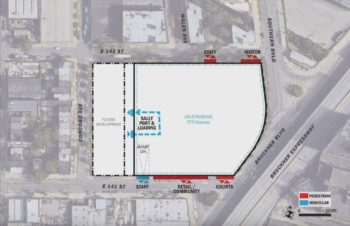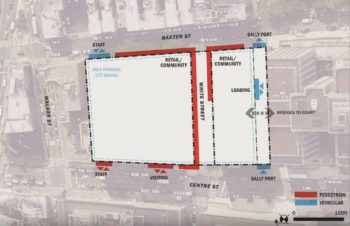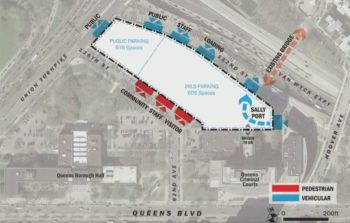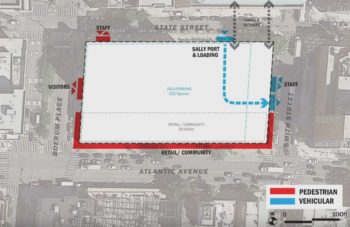
Map of proposed project site for the Bronx jail at 745 East 141st Street. Image Credit: NYC CPC
The four jails are set to replace Rikers island by 2027. On March 25, 2019, the City Planning Commission certified the City’s application for four borough-based jails as a part of the City’s plan to shut down Rikers Island. The four jails – in Manhattan, the Bronx, Queens, and Brooklyn – will have a total of 5,748 beds and a capacity of 5,000 inmates. The additional 748 beds will be used to account for taking occupied cells out of service for repairs, separating inmates based on gender or sentenced versus non-sentenced or other space needs.
Purpose of the project
According to Elizabeth Glazer, the Director of the Mayor’s Office of Criminal Justice, there are currently eleven jails citywide with a capacity of over 11,000 people. Five years ago, there were approximately 11,000 people in jail in New York City. The number of people in jail has now dropped to approximately 7,800 people. The City aims to drop that number to 5,000 people in jail by 2027.
The City hopes to achieve those numbers in part by closing down Rikers Island by 2027 and replacing Rikers with borough-based jails that will allow for more space for social services, recreation, education, and other facility needs as well as better access to legal counsel, courthouses, family members and staff.
The plan will be to open four jails in Manhattan, the Bronx, Queens, and Brooklyn, with an equal number of beds at each facility. Due to the small inmate population from Staten Island, the City did not feel like a fifth borough jail was warranted. Inmates from Staten Island will be housed in the Brooklyn facility.
Citywide Proposals
The City requested both citywide and borough specific actions. To facilitate such a project, the City applied for a zoning text amendment that would create a new special permit, which would only be applicable to the four properties associated with the borough-based jails project. The special permit allows for modifications to uses, bulk requirements like permitted FAR, accessory parking requirements, and off-street loading regulations for the four selected sites. According to the text of the special permit, any use modification must support the operation of the facility and will be compatible with the essential character of the surrounding area and the ground floor uses will be arranged in a “manner that is inviting to the public and will integrate the facility within the surrounding community.”
Manhattan

Map of proposed Manhattan jail at 124-125 White Street. Image Credit: NYC CPC
The Manhattan facility will be located at 124-125 White Street, the site of the current Manhattan Detention Complex adjacent to Chinatown. The current Manhattan Detention Complex currently holds up to almost 900 people undergoing the intake process or who are awaiting trial in Manhattan courts. The North Tower of the complex, located at 124 White Street, also currently has five ground floor retail tenants that will be displaced.
The existing complex would be torn down and replaced with a facility that could accommodate 1,437 beds and support space. The building would be divided into north and south wings, one at 124 White Street and the other at 125 White Street. The building would extend over White Street and White Street would become a pedestrian-only arcade. The building would have approximately 20,000 square feet for community, facility and/or retail space. The building would have a maximum height of 450 feet.
The retail and community space would be on Baxter Street and White Street. The sally ports and loading berths would be at 124 White Street, which would also have bridges that attached to the courthouse. The visitor and staff entrances would be on Centre Street at the 125 White Street building. The staff parking entrance would be on Baxter Street.
The project site is currently zoned for commercial use with a maximum FAR of 10.0 and four loading berths required. The Manhattan-specific special permit would increase the allowable FAR to 12.98 and only require two loading berths. Additionally, to allow for the creation of bridges connecting the north and south wing across White Street, the City also requested a demapping of White Street into a pedestrian-only street. The City also applied for an acquisition of a leasehold interest in the 6,300 square feet of retail space currently in the Manhattan Detention Complex currently held by the Walker Street-Chung Pak Local Development Corporation.
The Bronx
The Bronx facility will be located at 745 East 141st Street, the site of a current NYPD tow pound in Mott Haven. The new Bronx facility will have 1,437 beds, 40,000 square feet of community facility and retail space. The facility will also have 10,000 square feet of space reserved for courts. There will be a maximum roof height of 245 feet and an additional 40 feet for mechanical space. The site will have 575 accessory parking spots located below the facility.
The East 141st Street side would feature the accessory parking entrance for staff, as well as the entrances for the retail and community space and the court space. The East 142nd Street side would feature the staff and visitor entrances for the jail.
The area is currently zoned as a manufacturing district with a maximum commercial FAR of 5.0, with three required loading berths and no community facility uses permitted. To facilitate this project, a borough-specific special permit is being sought that would increase the commercial FAR to 7.75, limit to only two required loading berths, and allow for the 40,000 square feet of community facility space.
In addition, there will be a mixed-use development at 320 Concord Avenue between East 141st and East 142nd Streets adjacent to the jail. There will be space between the development and the jail to accommodate a sally port and a loading zone. Part of the City’s application is to rezone this portion of the site from a manufacturing district to a mixed manufacturing and residential district with a maximum residential FAR of 6.0 with mandatory inclusionary housing. The rezoning would allow for the creation of approximately 235 affordable housing units and 31,000 square feet of community facility or retail space.
Queens

Map of proposed Queens jail at 126-02 82nd Avenue. Image Credit: NYC CPC
The Queens facility will be located at 126-02 82nd Avenue in Kew Gardens. The project site is the current site of the decommissioned Queens Detention Complex and an adjacent surface parking lot. The site runs from 132nd Street to the north, 126th Street to the south, the Queens Criminal Court to the southeast, Union Turnpike to the west and the Van Wyck Expressway and Hoover Avenue to the east.
The current Queens Detention Complex is not used for overnight stays and is only occasionally used to temporarily hold those with court appearances that day. The facility will accommodate 1,437 beds and support spaces and will have 25,000 square feet of community facility space. The facility will have a maximum height of 270 feet. There will be 605 accessory parking spaces and a public parking garage with 676 parking spaces.
The new Queens facility will contain centralized care services for the entirety of the borough-based jail system. The new facility would also be connected to the courthouse like the complex is today.
The public parking garage will be in the top left corner of the lot on the corner of Union Turnpike and 126th Street. Access to the public garage will be on 132nd Street and Union Turnpike.
The community, staff and visitor entrances to the jail will be on 126th Street. Staff parking and a loading berth will be on 132nd Street.
The project site is currently zoned for underlying commercial use at a FAR of 3.4 with four required loading berths. To facilitate this project, the City requested a Queens specific special permit to increase the maximum FAR to 4.63 and require only two loading berths. Additionally, the City requested to demap the portion of 82nd Avenue between 126th Street and 132nd Street to incorporate that square footage into the project site.
Brooklyn
The Brooklyn facility will be located at 275 Atlantic Avenue, which is the current location of the Brooklyn Detention Complex with State Street to the north, Atlantic Avenue to the south, Boerum Place to the west and Smith Street to the east on the edge of the Downtown Brooklyn neighborhood. The current complex would be torn down and replaced with a new facility accommodating 1,437 beds and support space. The new facility would also have approximately 30,000 square feet of community, facility and possible retail space. There will be 292 accessory parking spaces. The facility will have a maximum roof height of 395 feet. The new facility would connect to tunnels below State Street that connect to the courthouse across the street.

Map of the proposed Brooklyn jail at 275 Atlantic Avenue. Image Credit: NYC CPC
The retail and community space would be on Atlantic Avenue. The visitor’s entrance would be on Boerum Place and the staff entrance would be on State Street. The sally port and loading zone entrance would be on State Street and exit out onto Smith Street. The staff parking entrance would also be on Smith Street.
The project site is currently zoned for commercial use with a FAR of 6.0, requires four loading berths, and does not allow for current community facility space on Atlantic Avenue. To facilitate this project, the City is requesting a Brooklyn-specific special permit that would allow for a commercial FAR of 17.95, require only two loading berths, and allow for 40,000 square feet of community facility space.
Additionally, the city is requesting a city map amendment to adjust the above- and below- grade volumes on State Street where the new facility would connect to underground tunnels attached to the courthouse across the street. The City is also considering the possibility of adding bridges between the courthouse and the jail across State Street but those bridges would need to be at least 40 feet above ground.
CityLand reached out to the Mayor’s Office of Criminal Justice to inquire about the timeline for closing the Manhattan and Brooklyn Detention Complexes and where the people there would go once the facilities were closed for demolition. According to the Office, “The City is still developing a phasing plan for the demolition of existing borough facilities in Manhattan and Brooklyn to allow new facilities to be built in order to close the jails on Rikers Island. This could mean utilizing existing capacity outside of these facilities, including potentially on Rikers Island. As the number of people in jail continues its decline, we can continue to minimize the overall numbers of detention, including on Rikers Island, while moving toward closing the jails on Rikers Island on the fastest timeline possible.”
Environmental Impact
The for the Draft Environmental Impact Statement was issued on March 22, 2019.
According to the Final Scope of Work, the Manhattan project could have significant adverse impacts on historic and cultural resources, an impact on traffic with transportation and an impact on pedestrians due to construction.
The Bronx and Queens projects could have significant adverse impacts on traffic with transportation, and pedestrians, traffic and noise with construction.
The Brooklyn project could have significant adverse impacts on historic and cultural resources, an impact on traffic with transportation and pedestrians, traffic and noise due to construction.
None of the project sites were found to have significant adverse impacts on other factors like open space, shadows, water and sewer infrastructure, public health, neighborhood character, air quality or urban design and visual resources.
Design
The city will be using the design-build project delivery method for the borough-based jails, meaning that one entity works under a single contract to provide both design and construction services. The design-build system will save time and expense due to the collaborative nature of working together under one contract. This is the first time that design-build is being used for a project going through ULURP. According to City Planning Commission Chair Marisa Lago, as a result of the first use of design-build with ULURP, the City Planning Commission is working closely with the City’s Department of Design and Construction (DDC) to “develop a stakeholder engagement process that prioritizes getting input on design.”
DDC has established a project design consultant team led by AECOM Construction and Hill West Architects. Beverly Pryor of AECOM will be the design manager and will be responsible for community engagement, including leading public workshops, working with design professionals, creating design recommendations based on stakeholder feedback and facilitating a design advisory group. The design advisory group will ensure that all of the design work takes community feedback into the design.
Next Steps
The applications will now enter the ULURP process. The applications will now be subject to community board review by Bronx Community Board 1, Brooklyn Community Board 2, Manhattan Community Board 1 and Queens Community Board 9. After community board review, the projects would be subject to review by each borough president before returning to the City Planning Commission for public hearings later this year.
For CityLand’s previous coverage of the borough-based jails project, read the transcript of Hon. Jonathan Lippman discussing the closure of Rikers Island at the 159th CityLaw Breakfast here and watch the video of the breakfast here.
By: Veronica Rose (Veronica is the CityLaw Fellow and a New York Law School Graduate, Class of 2018.)

